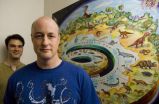The dramatic decline in DNA sequencing costs is making personal genome sequencing a reality. Already, significant progress has been made in applying whole genome sequencing to cancer prognosis and early childhood disease. Examples include the 2010 publications on Miller Syndrome in Nature Genetics and Science, and similar studies aimed at identifying the unknown genetic defects responsible for some early childhood diseases.
However, a data interpretation bottleneck has limited the utility of personal genome information for medical diagnosis and preventive care. VAAST is a new algorithm to assist in overcoming this bottleneck. VAAST is the product of a collaboration between Mark Yandell, Ph.D., Associate Professor of Human Genetics at the University of Utah School of Medicine, and colleagues, and the Omicia scientific team under the leadership of Martin Reese, Ph.D., the company's CEO and Chief Scientific Officer.
In the Genome Research paper, Yandell and colleagues show that VAAST provides a highly accurate, statistically robust means to rapidly search personal genomes for genes with disease-causing mutations. The authors demonstrate that as few as three genomes from unrelated children, or those of the parents and their two children, are sufficient to identify disease causing mutations.
"The big challenge in genomic medicine today is how to sift through the millions of variants in a personal genome sequence to identify the disease-relevant variations," said Dr. Reese. "It's a classic needle in a haystack problem, and VAAST goes a long way toward solving it. We look forward to integrating VAAST into the Omicia Genome Analysis System currently under development for clinical applications."
Dr. Yandell added: "VAAST solves many of the practical and theoretical problems that currently plague mutation hunts using personal genome sequences. Our results demonstrate that this tool substantially improves upon existing methods with regard to statistical power, flexibility, and scope of use. Further, VAAST is automated, fast, works across all variant population frequencies and is sequencing platform independent."
In a separate paper published this week in the American Journal of Human Genetics, Gholson Lyon, M.D., Ph.D., previously at University of Utah and now at the Children's Hospital of Philadelphia, and colleagues report the use of VAAST as part of an international effort to identify the mutation responsible for a newly discovered childhood disease. This new illness, which they are tentatively calling Ogden Syndrome, is characterized by aged appearance, craniofacial abnormalities, cardiac arrhythmias and other symptoms. The team used X-chromosome exon capture and next-generation sequencing and the VAAST tool to quickly and unambiguously identify the disease-causing mutation in the NAA10 gene that has resulted in this fatal disease in children of two unrelated families.
"VAAST can identify disease-causing mutations with greater accuracy, using far fewer individuals and more rapidly than was previously possible," said Dr. Lyon. "We are now applying VAAST to many other unknown conditions, including rare Mendelian disorders and other common disorders such as ADHD and autism."
Commenting on the significance of this development, Eric J. Topol, M.D., Director, Scripps Translational Science Institute and Chief Academic Officer, Scripps Health, commented: "One of most important and exciting opportunities in genomic medicine is the newfound ability to pinpoint the root cause of an unknown idiopathic disease in an individual. The VAAST tool will markedly facilitate this and represents a major advance in the field. It fulfills a significant unmet need of interpreting whole genome sequences and will have a remarkable impact on accurate genomic diagnosis of many individuals going forward."
INFORMATION:
The development of VAAST was funded by the National Human Genome Research Institute through an American Recovery and Reinvestment Act Grand Opportunity (GO) grant. GO grants focus on transformative technologies and large, potentially high-impact projects.
Citations: Yandell M, Huff CD, Hu H, Singleton M, Moore B, Xing J, Jorde LB, Reese MG. 2011.A probabilistic disease-gene finder for personal genomes. Genome Res. 21: (pages to come) doi:10.1101/gr.123158.111.
Rope, A et al. "The use of VAAST to identify an X-linked disorder resulting in lethality in male infants due to N-terminal acetyltransferase deficiency, American Journal of Human Genetics, published online June 23 , 2011. doi: 10.1016/j.ajhg.2011.05.017.
About Omicia, Inc.
Based in Emeryville, California, Omicia is developing scalable and fully integrated informatics systems specifically designed to interpret human genome sequences for research and clinical applications. Omicia's mission is to help doctors and patients better understand how an individual's genome affects their health and disease risks. The company is the recipient of multiple NIH grants to fund its innovations. For more information about Omicia, please visit www.omicia.com.
About the University of Utah School of Medicine
The University of Utah School of Medicine combines excellence in teaching, research, and clinical expertise to train tomorrow's physicians for the rapidly changing world of medicine. With a faculty of more than 1,000 physicians and researchers and 22 clinical and basic-science departments, the School of Medicine is recognized for interdisciplinary research in the genetics of disease, cancer, biomedical informatics, infectious diseases, and other areas of leading-edge medicine. The School of Medicine trains the majority of Utah physicians for their medical degree, residency or fellowship. www.medicine.utah.edu.
Disclosures: Dr. Yandell has a financial interest in Omicia.
Contacts:
Phil Sahm, University of Utah Health Sciences Public Affairs
phil.sahm@hsc.utah.edu; (801) 581-2517; (801) 339-9615 (pager)
Mark Yandell, Ph.D., University of Utah Department of Human Genetics
myandell@genetics.utah.edu; (801) 587-7707 (office); (801) 259-6083 (cell)
Note: Dr. Yandell will be at a conference Sunday through Tuesday, June 19-21, and available only by e-mail. He can be reached by cell on Friday, June 17 and Saturday, June 18, and at his office on and after Wednesday, June 22.
Nicole Litchfield, for Omicia
nicole@bioscribe.com; (415) 793-6468
END
